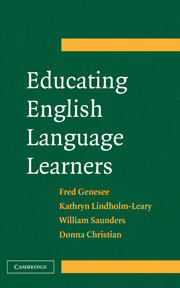4 - Literacy: Instructional Issues
Published online by Cambridge University Press: 13 July 2009
Summary
INTRODUCTION
Literacy instruction is undoubtedly one of the critical focal points in the education of all children – native English speakers as well as English language learners (ELLs). Literacy is both an end in itself and a means to other ends since, without formal education, most children would not learn to read and write and, without reading and writing skills, children would not be able to learn and function effectively in school and beyond. Clearly, there are challenges in teaching reading and writing to ELLs that exceed those that educators face when teaching native English speakers. The focus of this chapter is on research that has examined the instructional, family and community, and assessment issues related to reading and writing by ELLs. For purposes of this review, reading and writing include the production or comprehension of written language and behaviors related to the production and comprehension of written language – for example, strategies for comprehending unknown written words or engagement in reading and writing activities. This encompasses a broad range of outcome measures, as will become evident in the following review. The studies were categorized into four broad topics:
Instructional Approaches
Language of Instruction
Family and Community
Assessment
INSTRUCTIONAL APPROACHES
Research reviewed in this section has examined a wide variety of different methods, techniques, and strategies for promoting the reading and writing skills of ELLs.
- Type
- Chapter
- Information
- Educating English Language LearnersA Synthesis of Research Evidence, pp. 109 - 175Publisher: Cambridge University PressPrint publication year: 2006
- 1
- Cited by



